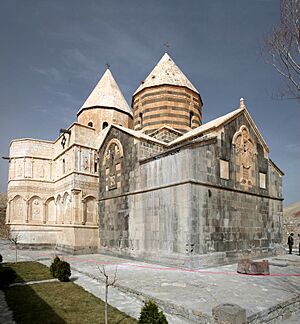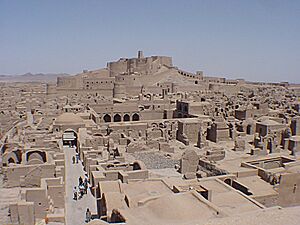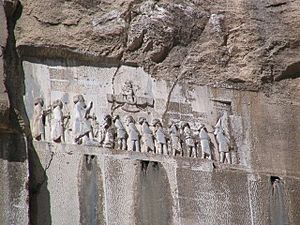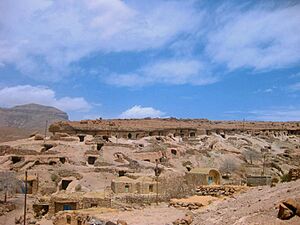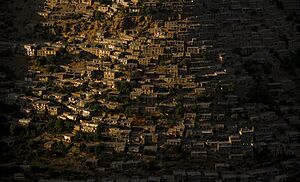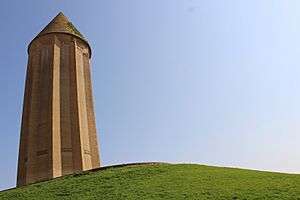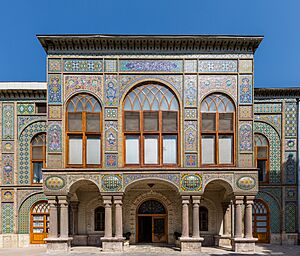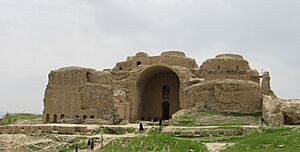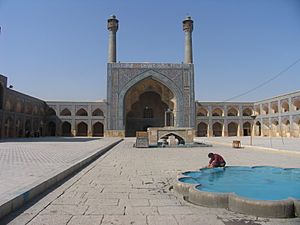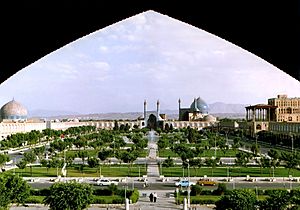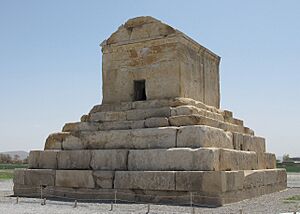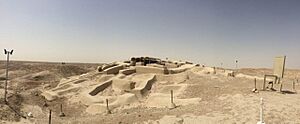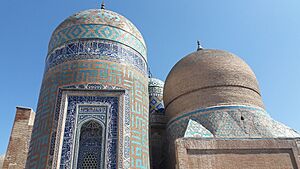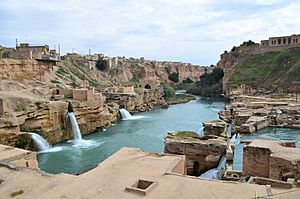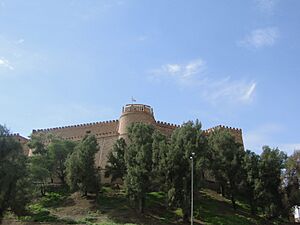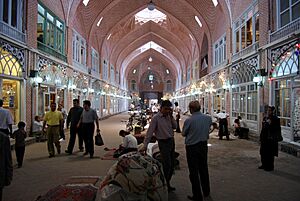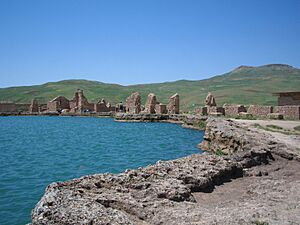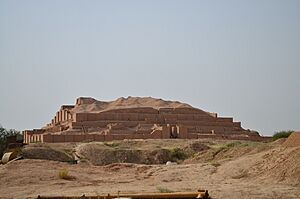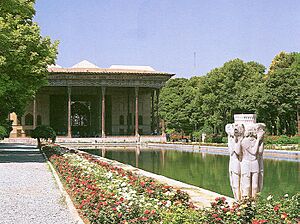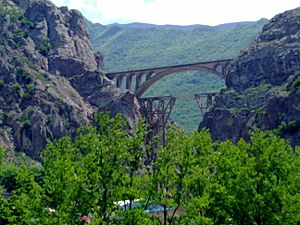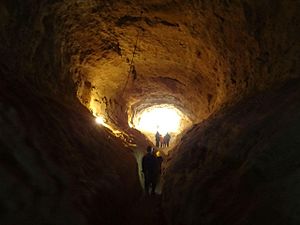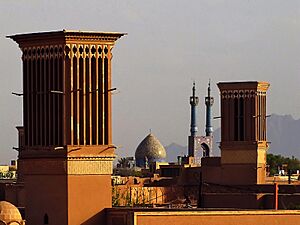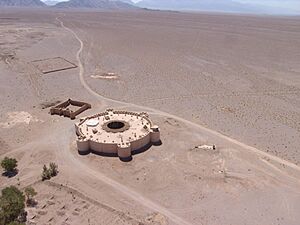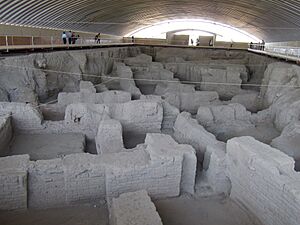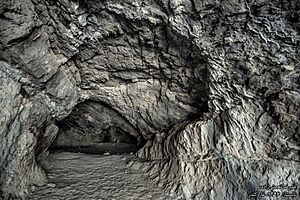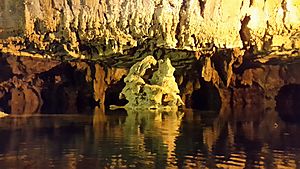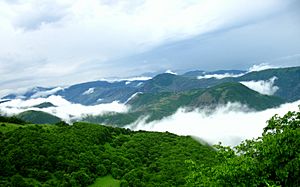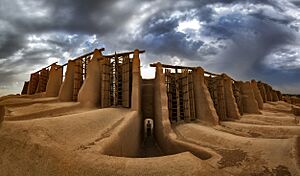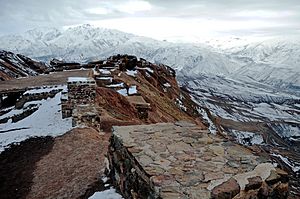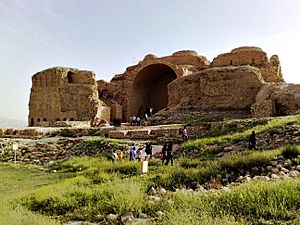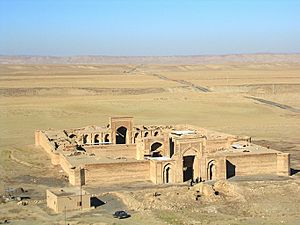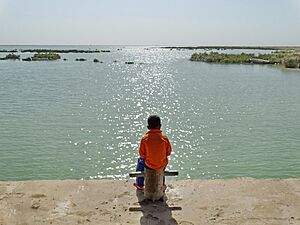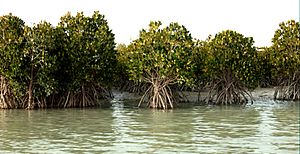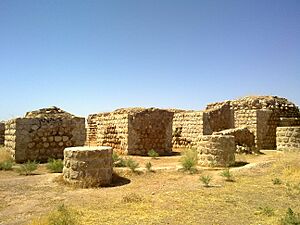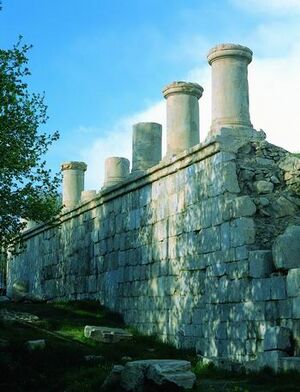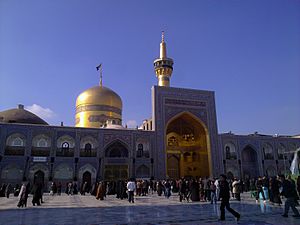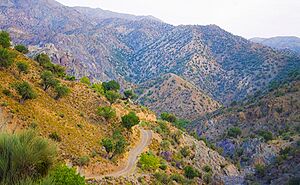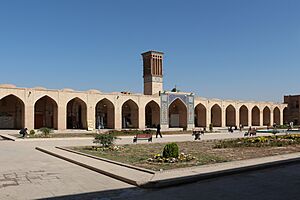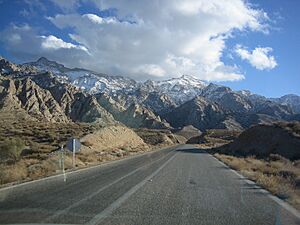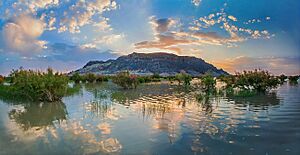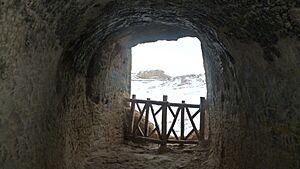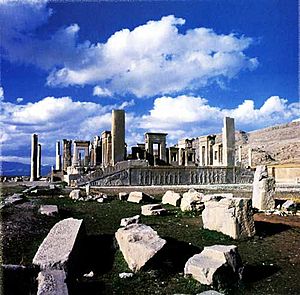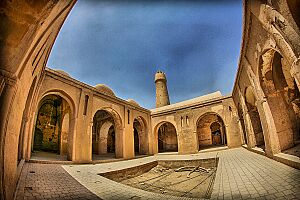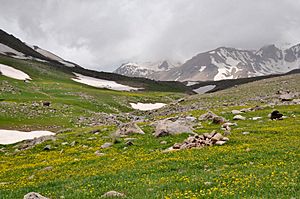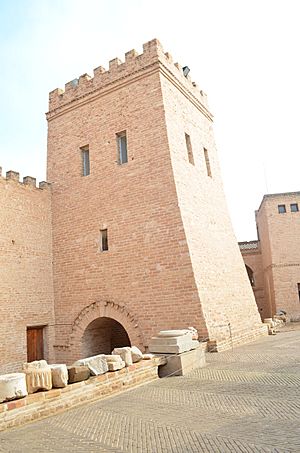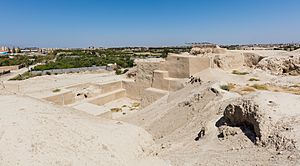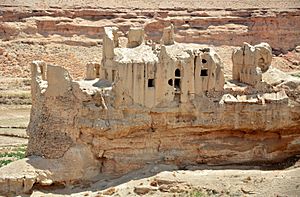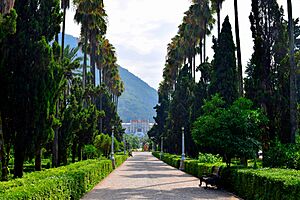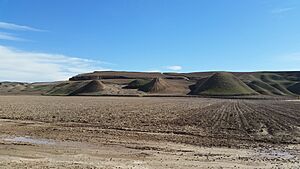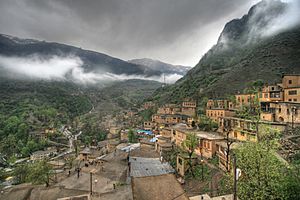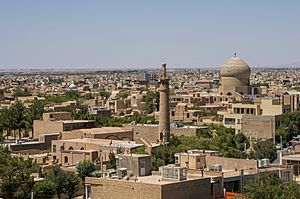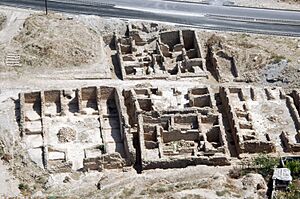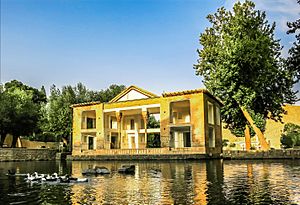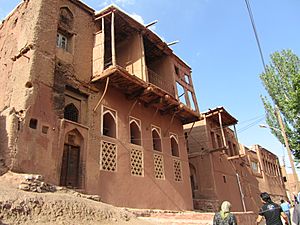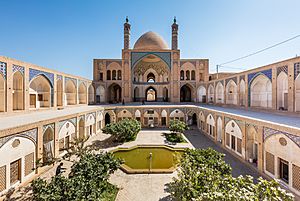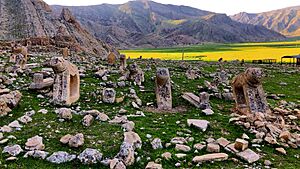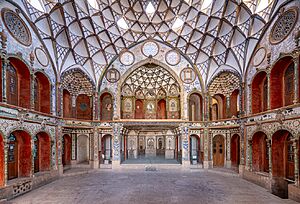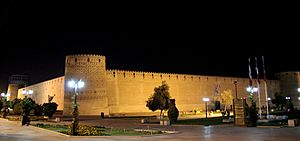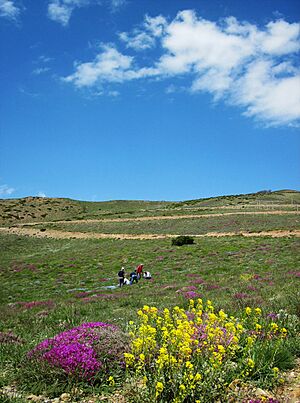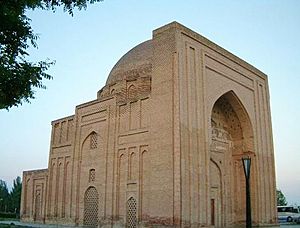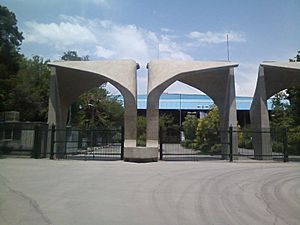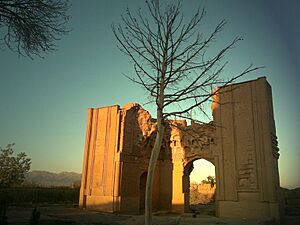List of World Heritage Sites in Iran facts for kids
Have you ever heard of places so special they are protected by the whole world? These are called United Nations Educational, Scientific and Cultural Organization (UNESCO) World Heritage Sites. They are important spots that show off amazing culture or natural heritage. UNESCO started this program in 1972 to help keep these places safe.
Cultural heritage includes things like old buildings, cool statues, or ancient writings. Natural heritage means special natural areas. This could be unique rock formations, homes for rare animals, or beautiful landscapes. Iran joined this program on February 26, 1975. This meant its historical sites could be added to the list. As of July 2025, Iran has twenty-nine World Heritage Sites.
Iran's first three sites were added in 1979. These were Meidan Naghshe Jahan, Isfahan, Persepolis, and Tchogha Zanbil. They were the only ones for a long time. Then, in 2003, Takht-e Soleyman was added. The newest sites, The Prehistoric Sites of the Khorramabad Valley, joined the list in 2025. Iran also has 58 other places that might become World Heritage Sites in the future.
Iran's Amazing World Heritage Sites
UNESCO uses ten rules to pick World Heritage Sites. Each place must meet at least one rule. Rules one to six are for cultural sites. Rules seven to ten are for natural sites.
* Transnational site
| Site | Image | Location | Year listed | UNESCO data | What Makes It Special |
|---|---|---|---|---|---|
| Armenian Monastic Ensembles of Iran | West Azerbaijan province | 2008 | 1262; ii, iii, vi (cultural) | These old Armenian monasteries in northwest Iran are super important. They show off amazing Christian architecture from the 7th century. They mix Armenian, Byzantine, Orthodox, and Persian styles. These sites helped spread Armenian culture for centuries. Today, they are still active places of worship and show how strong Armenian religious history is. | |
| Bam and its Cultural Landscape | Kerman province | 2004 | 1208bis; ii, iii, iv, v (cultural) | Bam is an ancient city in a desert. It dates back to the Achaemenid time (6th–4th centuries BC). It was a busy trade center from the 7th to 11th centuries, known for silk and cotton. Bam used qanāts, which are old underground water systems. The Arg-e Bam is a well-preserved fort city made with traditional mud-brick building methods. | |
| Bisotun | Kermanshah province | 2006 | 1222; ii, iii (cultural) | Bisotun is on an old trade route in Iran. It has artifacts from many different time periods. The most famous part is a carving and writing from Darius I from 521 BC. It shows him becoming king and ruling the Persian Empire. The site also has older and newer relics, showing a long history. | |
| Cultural Landscape of Maymand | Kerman province | 2015 | 1423rev; v (cultural) | Maymand is a unique village in southern Iran. People here live a semi-nomadic life. They move to mountain pastures in spring and autumn. In winter, they live in special cave homes. This way of life shows how people have adapted to living in dry areas for a very long time. | |
| Cultural Landscape of Hawraman/Uramanat | Kurdistan province | 2021 | 1647; iii, v (cultural) | The Hawraman/Uramanat area is home to the Kurdish Hawrami people. They have lived here since 3000 BCE. The region has steep mountains and special tiered villages. The Hawrami people move between different elevations with the seasons. Their villages show how they have cleverly adapted to mountain life. | |
| Gonbad-e Qābus | Golestan province | 2012 | 1398; i, ii, iii, iv (cultural) | This tower is the tomb of Qābus Ibn Voshmgir, built in 1006 AD. It connects Central Asian nomads with Iranian culture. The 53-meter-high tower is all that is left of Jorjan, an old city. Its clever brick design shows the amazing math and science skills of the Muslim world long ago. | |
| Golestan Palace | Tehran | 2013 | 1422; ii, iii, iv (cultural) | The Golestan Palace is a beautiful building from the Qajar era. It mixes traditional Persian art with Western styles. It's one of Tehran's oldest buildings. It became the main palace for the Qajar rulers in 1779. The palace has lovely gardens and unique decorations from the 19th century. It shows a new style that blended old Persian ideas with newer building methods. | |
| Lut Desert | Kerman and Sistan and Baluchestan provinces | 2016 | 1505; vii, viii (natural) | The Lut Desert in southeast Iran is one of the hottest and driest places on Earth. Strong winds here create amazing landforms called yardangs. These are huge ridges carved by the wind. The desert also has rocky plateaus and vast sand dunes. It's a great example of how natural forces constantly shape our planet. | |
| Sassanid Archaeological Landscape in Fars province (Bishabpur, Firouzabad, Sarvestan) | Fars province | 2018 | 1568; ii, iii, v (cultural) | In Fars Province, there are eight old sites from the Sassanian Empire (224 to 658 CE). These sites include well-preserved city designs, forts, and palaces. They show how the Sassanian Empire started and ended. Some were built by Ardashir Papakan, the first Sassanian ruler. These places show how Sassanian architecture blended with the land. They also show influences from Roman art, which later shaped Islamic buildings. | |
| Masjed-e Jāmé of Isfahan | Isfahan, Isfahan province | 2012 | 1397; ii (cultural) | The Masjed-e Jāmé of Isfahan is a very old mosque, built in 841 AD. It shows how mosque building changed in Iran over 12 centuries. It's the oldest mosque still standing in Iran. Its design influenced mosques across Central Asia. This mosque was the first to use the Sassanid four-courtyard style in Islamic buildings. Its unique domes also inspired other buildings. It has many beautiful decorations that show the history of Islamic art. | |
| Naqsh-e Jahan Square | Isfahan, Isfahan province | 1979 | 115; i, v, vi (cultural) | This huge square was built in the 17th century by Shah Abbas I. It's a perfect example of Safavid Persian architecture. It has grand buildings and two-story arcades. You can see the Royal Mosque with its detailed Islamic art. The Mosque of Sheykh Lotfollah is known for its beautiful decorations. The Qaysariyyeh Portico leads to the main market. There's also an old palace from before the Safavid era. These buildings show the peak of Safavid Persia's culture and society. | |
| Pasargadae | Fars province | 2004 | 1106; i, ii, iii, iv (cultural) | Pasargadae was the first capital of the Achaemenid Empire. It was built by Cyrus the Great in the 6th century BC. This site includes the tomb of Cyrus, gardens, and palace ruins. It shows early Persian art and architecture. It's a symbol of the first great multicultural empire. | |
| Persepolis | Fars province | 1979 | 114; i, iii, vi (cultural) | Persepolis was the capital of the Achaemenid Empire. Darius I started building it in 518 B.C. This amazing city was built on a huge platform. The "king of kings" built grand palaces here, inspired by Mesopotamian designs. The ruins show the empire's power and the builders' incredible skill. These huge buildings and detailed carvings are treasures of the Achaemenid Empire. | |
| Shahr-e Sukhteh | Sistan and Baluchestan province | 2014 | 1456; ii, iii, iv (cultural) | Shahr-i Sokhta, or 'Burnt City', was an important Bronze Age city. It was a trade hub on the Iranian plateau. The city was founded around 3200 BC and lived for many centuries. It had special areas for homes, workshops, and burials. Changes in water and climate caused the city to be abandoned. Its mud-brick buildings and many artifacts are very well preserved. They teach us a lot about early societies and ancient civilizations. | |
| Sheikh Safi al-din Khānegāh and Shrine Ensemble in Ardabil | Ardabil province | 2010 | 1345; i, ii, iv (cultural) | This spiritual center was built between the 16th and 18th centuries. It's a great example of traditional Iranian architecture. It has a library, mosque, school, and other buildings. The path to the shrine has seven parts, showing the seven steps of a Sufi spiritual journey. The buildings are beautifully decorated and hold many old artifacts. It's a unique look into medieval Islamic architecture and Sufi beliefs. | |
| Shushtar Historical Hydraulic System | Khuzestan province | 2009 | 1315; i, ii, v (cultural) | Shushtar's Hydraulic System is an amazing feat of engineering. It started with Darius the Great in the 5th century B.C. Canals from the Kârun River bring water to Shushtar. This water powers mills and creates waterfalls. The system waters about 40,000 hectares of land. It includes old castles, dams, bridges, and mills. This system shows the advanced skills of the Elamites, Mesopotamians, Nabateans, and Romans. | |
| Soltaniyeh | Zanjan province | 2005 | 1188; ii, iii, iv (cultural) | The mausoleum of Oljaytu was built from 1302 to 1312 in Soltaniyeh. This city was once the capital of the Ilkhanid dynasty. The mausoleum is a masterpiece of Persian architecture. Its octagonal shape has a stunning 50-meter-high dome. The dome is covered in blue tiles and surrounded by eight tall minarets. It's the first known double-shelled dome in Iran. Its beautiful inside decorations are thought to have inspired the Taj Mahal. | |
| Susa | Khuzestan province | 2015 | 1455; i, ii, iii, iv (cultural) | Susa is in southwest Iran, near the Shavur River. It has many ancient mounds and Ardeshir's palace. Susa shows a long history of cities, from 5th millennium BCE to 13th century CE. It tells the story of the Elamites, Persians, and Parthians. You can see ruins of homes, palaces, and government buildings. | |
| Tabriz Historic Bazaar Complex | East Azerbaijan province | 2010 | 1346; ii, iii, iv (cultural) | The Tabriz bazaar is a very old trading center. It was important during the Silk Road times. It has many connected, covered brick buildings. The bazaar became famous in the 13th century. Tabriz was the capital of the Safavid empire then. Even after losing its capital status, it stayed a major market until the late 18th century. Today, it's a great example of Iran's traditional markets. | |
| Takht-e Soleyman | West Azerbaijan province | 2003 | 1077; i, ii, iii, iv, vi (cultural) | The Takht-e Soleyman site is in northwest Iran, in a volcanic mountain area. It has a main Zoroastrian temple rebuilt in the 13th century. There's also a Sasanian temple (6th and 7th centuries) for the goddess Anahita. This site influenced Islamic building designs. | |
| Tchogha Zanbil | Khuzestan province | 1979 | 113; iii, iv (cultural) | Tchogha Zanbil was a sacred city of the ancient Elamite Kingdom. It's surrounded by three huge walls. It was built around 1250 B.C. but was never finished. An invasion by Ashurbanipal stopped its construction. | |
| The Persian Garden | Fars, Kerman, Razavi Khorasan, Yazd, Mazandaran, and Isfahan provinces | 2011 | 1372; i, ii, iii, iv, vi (cultural) | This site includes nine gardens across different provinces. They show the many styles of Persian gardens. These gardens follow rules from the 6th century BC. They are divided into four parts and use water for beauty and irrigation. They symbolize Eden and the Zoroastrian elements. These gardens influenced garden design in places like India and Spain. | |
| Trans-Iranian Railway | Mazandaran, Tehran and Khuzestan provinces | 2021 | 1585: ii, iv (cultural) | The Trans-Iranian Railway is 1,394 kilometers long. It connects the Caspian Sea to the Persian Gulf. It goes through mountains, rivers, and forests. Built from 1927 to 1938, it was a huge engineering challenge. Workers had to cut through mountains and build many bridges and tunnels. The project was paid for by Iranian taxes to stay independent. | |
| Persian Qanat | Razavi Khorasan, South Khorasan, Yazd, Kerman, Markazi and Isfahan provinces | 2016 | 1506; iii, iv (cultural) | Iran's dry areas use an old system called qanat. It brings water from underground to farms and towns. Eleven qanats are on this list. They show how communities shared water fairly. This system is a great example of how people adapted to desert climates. | |
| Historic City of Yazd | Yazd, Yazd province | 2017 | 1544; iii, iv (cultural) | Yazd is in the middle of the Iranian plateau. It shows how people survive in the desert using Qanat water systems. The city has old mud-brick buildings and traditional neighborhoods. It also has markets, religious sites, and the beautiful Dolat-abad garden. | |
| Hyrcanian Forests | Golestan, Mazandaran and Gilan provinces | 2019 | Natural:
(ix) |
The Hyrcanian forests cover parts of three Iranian provinces. They are found in the southern and southwestern areas of Golestan province. These ancient forests are home to many different plants and animals. They are a vital natural treasure. | |
| The Persian Caravanserai | (various) | 2023 | 1668; ii, iii (cultural) | Caravanserais were roadside inns. They gave food, water, and shelter to travelers and traders. Their locations depended on water and safety. The 56 caravanserais on this list are just a few of the many built along Iran's old roads. | |
| Hegmataneh | Hamadan province | 2024 | 1716; ii, iii (cultural) | Hegmataneh was the capital of the Medes in the 7th century BCE. It later became a summer capital for the Parthian and Persian empires. This ancient city has a unique circular design. Gold and silver items found here show how rich it was. Old books describe its beauty and gold-decorated buildings. It was an important center for many rulers over time. | |
| The Prehistoric Sites of the Khorramabad Valley | Lorestan province | 2025 | 1744; iii (cultural) | Khorramabad Valley is full of ancient sites and relics. It's a key area for studying Iran's old civilizations. This site includes six caves and rock shelters. Kaldar Cave, shown in the picture, is one of them. |
Future World Heritage Sites: Iran's Tentative List
In addition to the sites already on the World Heritage list, countries can suggest other places. These are put on a "tentative list." A site must be on this list before it can be nominated for the main World Heritage list. As of July 2025, Iran has 58 places on its tentative list.
| Site | Image | Location (province) | UNESCO criteria | Year listed | Why It's Special |
|---|---|---|---|---|---|
| Ali-Sadr Cave | Hamadan province | vii, viii, ix (natural) | 2007 | Ali Sadr Cave is famous for its huge underground lakes. You can explore them by boat! It has amazing stalactites and stalagmites. This natural wonder is carefully managed to protect it for the future. | |
| Arasbaran Protected Area | Azerbaijan Province | vii, viii, ix, x (natural) | 2007 | The Arasbaran Protected Area is a large natural space in Iran. It has mountains and diverse habitats. It's home to about 1,000 different kinds of plants and animals. Some rare species live here. It became a protected area in 1971 and a UNESCO wildlife refuge in 1976. | |
| Asbaads (Windmill) of Iran. Nashtifan | Khurasan-e Razavi, Sistan and Balochestan | i, ii, iv, v (cultural) | 2017 | Eastern Iran has strong winds all year. People here invented "Asbad" windmills to grind grains. These windmills are built on high places to catch the wind. They also protect towns from storms. Wind power has been used in Iran for 3000 years. Iranian windmills even influenced European designs. | |
| Bastam and Kharghan | ii, iii, iv (cultural) | 2007 | This site includes the complex of Sheikh Bayazid Bastami, an important Sufi leader. It also has an old mosque and parts of an ancient city wall. The oldest buildings here are from the 8th and 9th centuries AD. | ||
| Bazaar of Qaisariye in Laar | Laar, Fars province | i, ii, iii, vi (cultural) | 2007 | Laar is an example of old city planning. Its design shows how it recovered after a big earthquake. The Bazaar of Qaisariye and a square with a polo gate show how the city was rebuilt. | |
| Cultural Landscape of Alamutt | Village of Alamout,
Qazvin |
ii, iv, v, vi, viii (mixed) | 2007 | Hassan Sabah's castle is on a 220-meter cliff. It's 2163 meters above sea level in the Alborz Mountains. The remaining walls and towers are made of stone. The castle covers ten thousand square meters. Its buildings are spread across the steep land. | |
| Damavand | Mazandaran province | vii, viii, ix, x (natural) | 2008 | Mount Damavand is Iran's tallest peak, about 5,628 meters high. It's an inactive volcano. The mountain has many hot springs and is always covered in snow. It has about 2,000 plant species, including many unique ones. | |
| Firuzabad Ensemble | Firuzabad, Fars | (cultural) | 1997 | The Firuzabad area shows the rich history of the Sassanian period. It has the circular City of Gur, the Palace of Ardashir, and the Qal'eh Dokhtar fortress. There are also carvings showing important events and writings. These sites highlight the empire's advanced city planning and architecture. | |
| Ghaznavi- Seljukian Axis in Khorasan | Khorasan province | i, ii, iii, iv (cultural) | 2007 | Many caravanserais (roadside inns) from the Seljuk period are along the Silk Road. Places like Robat-Sharaf and Robat-Mahi show how important this trade route was. These historical buildings are found in the Khorasan region. | |
| Hamoun Lake | Sistan and Baluchistan Province | vii, viii, ix, x (natural) | 2008 | This desert lake is in eastern Iran. It has three main parts. When there's a lot of rain, the lake can cover about 5,700 square kilometers. Most of it is in Iran, with some in Afghanistan. | |
| Harra Protected Area | Hormozgan province | vii, viii, ix, x (natural) | 2008 | The Khuran Strait reserve is between Qeshm Island and southern Iran. It has large mangrove forests. This area is important for many water birds. It became a protected area in 1972 and a biosphere reserve in 1976. | |
| Historic ensemble of Qasr-e Shirin | Qasr-e Shrin, Kermanshah province | (cultural) | 1997 | This is an important archaeological site from the Sassanian era and earlier. It has ruins of palaces and temples. It shows the area's importance as a cultural and political center. Qasr-e Shirin is also famous for the love story of Khosrow and Shirin. | |
| Temple of Anahita of Kangavar | Kangavar, Kermanshah province | iii (cultural) | 2007 | This ancient site was for Anahita, the Persian water goddess. It has grand terraces and huge stairways. The stone columns suggest a mix of Greek and Persian building styles. | |
| Imam Reza Shrine | Mashhad, Khurasan-e Razavi Province | i, ii, iii, iv, vi (cultural) | 2017 | This huge complex is for Imam Reza, an important Shia Imam. Millions of pilgrims visit every year. It has a mosque, a tomb, a library, and other religious buildings. Its architecture is known for beautiful tile work, domes, and minarets. | |
| Industrial Heritage of textile in the central Plateau of Iran | Isfahan, Yazd and Kerman provinces | i, ii, iii, iv (cultural) | 2017 | This area has many old mills and workshops. Artisans used old and new methods to make textiles. These textiles were known for their quality and designs. This site shows how the region helped develop textile production and shaped society. | |
| Jiroft | Kerman province | ii, iii, v, vi (cultural) | 2007 | Jiroft is known for its amazing artifacts, like carved stone vessels. It's a key site for understanding early cities and trade in the region. These finds suggest it was a major center for crafts and trade. It might have been connected to ancient Mesopotamia and the Indus Valley. | |
| Blue Mosque, Tabriz | Tabriz, East Azerbaijan province | i, ii, iii, iv (cultural) | 2007 | This historic mosque is famous for its beautiful blue tiles. It was built in 1465. An earthquake in 1779 damaged it, but it has been restored. Its design mixes Islamic and Persian styles. It's a symbol of Tabriz's rich history. | |
| Kerman Historical-Cultural Structure | Kerman province | i, ii, iii, iv, vi (cultural) | 2008 | This structure includes mosques, markets, caravanserais, and bathhouses. They show different historical periods from Islamic times to today. Kerman's layout with its old markets and narrow alleys is a great example of Persian city planning. It's known for its detailed tile work and mud-brick buildings. | |
| Khabr National Park and Ruchun Wildlife Refuge | Kerman province | vii, viii, ix, x (natural) | 2007 | This protected area has mountains, rivers, and plants. It's a home for endangered animals like Persian leopards and Asiatic black bears. It's also important for protecting water sources and regulating the climate. | |
| Mount Khajeh | Zabol, Sistan and Baluchistan Province | ii, iii, iv (cultural) | 2007 | Mount Khajeh is a flat-topped black hill. It rises from Hamoun Lake. It's important for archaeology. It has ruins of an ancient fort and pre-Islamic buildings. These include Zoroastrian fire temples and a Sasanian palace. It was a natural fortress and a religious center. | |
| Naqsh-e Rostam and Naqsh-e Rajab | Marvdasht, Fars province | (cultural) | 1997 | Naqsh-e Rostam is an ancient burial ground. It has rock-cut tombs of four Achaemenid kings, including Darius the Great. There are also impressive carvings from the Achaemenid and Sassanian periods. These sites show how ancient Persian empires buried their kings and celebrated victories. They offer important clues about the art and history of those times. | |
| Natural-Historical Complex / Cave of Karaftoo | Kurdistan province | (mixed) | 2017 | This cave system has unique rock formations. People have used it since ancient times for homes, worship, and defense. It has Greek writings that suggest it was for the god Hermes. The cave also has man-made rooms from different historical periods. | |
| Persepolis and other relevant buildings | Fars province | (cultural) | 2007 | This is an ancient archaeological site. It was the ceremonial capital of the Achaemenid Empire. It includes palaces, halls, and a treasury. Famous structures are the Gate of All Nations, the Apadana Palace, and the Tomb of Artaxerxes III. | |
| Persian Mosque | (various) | i, ii, iii, iv, vi (cultural) | 2025 | This nomination includes 17 historic mosques. They show the beauty and history of Persian mosque architecture. | |
| Qeshm Island | Hormozgan province | (natural) | 2007 | Qeshm is the largest island in the Persian Gulf. It has many natural attractions. These include the Hara Marine Forests and the Valley of Stars with its unique rock shapes. It's home to many animals like migratory birds and sea turtles. The island's culture is rich with traditional music and crafts. | |
| Sabalan | Ardabil province | (natural) | 2007 | Sabalan is a dormant volcano, 4820 meters high. It's Iran's third-highest mountain. It has hot springs that attract visitors. Sabalan is important in local stories and is seen as a sacred mountain. Its slopes are used by nomadic tribes for grazing. | |
| Salt Domes of Iran | Fars province, Bushehr, Hormozgan, Qom and Zanjan | (natural) | 2017 | Salt domes are formed when salt from deep underground pushes up through rock layers. Iran's salt domes are colorful and striking. They create unique homes for plants and animals. Some domes also have valuable salt and other minerals. | |
| Shush | 100 km south of Ahvaz, Khuzestan province | (cultural) | 1997 | Shush is an ancient city, one of the oldest in the world. People lived here as early as 4000 BCE. It was important in the Elamite, Persian, and Parthian empires. The site has ruins like the palace of Darius the Great. | |
| Silk Route (Also as Silk Road) | Khorasan province | i (cultural) | 2008 | The Silk Route in Iran refers to the parts of the ancient Silk Road that crossed the Iranian plateau. This network of trade routes connected East and West for centuries. It helped exchange goods, ideas, cultures, and technologies. Iranian cities like Nishapur and Isfahan became busy trade centers. | |
| Tepe Sialk | Isfahan province | (cultural) | 1997 | Tepe Sialk is an archaeological site from the 5th millennium BC. It has two main mounds with many layers of history. It helps us understand early farming societies in Iran. Artifacts like pottery and tools show how people lived and what they knew. A ziggurat-like structure suggests religious activities. | |
| Taq-e Bostan | Kermanshah, Kermanshah province | (cultural) | 2007 | Taq-e Bostan is an archaeological site with many ancient artifacts. It includes an old village and a Parthian burial site. The most famous parts are the Sassanid rock carvings. These show two large arches and amazing reliefs from that era. | |
| The Collection of Historical Bridges | Lorestan province | (cultural) | 2008 | Iran has many rivers and old bridges like Pol-e Dokhtar. These bridges helped connect people and trade. Bridge building was best during the Sasanian period. Lorestan has about sixty medieval bridges. They are some of the oldest and largest in the world. | |
| The Complex of Izadkhast | Fars province | (cultural) | 2007 | This complex includes a fortress, a caravanserai, and a bridge. It's located along old trade routes. The fortress is on a natural rock, showing old defense styles. The caravanserai offered lodging for travelers. The bridge helped goods and people move across the region. | |
| The Cultural-Natural Landscape of Ramsar | City of Ramsar, Province of Mazandaran | (mixed) | 2007 | Ramsar is a city known for its beautiful natural scenery and cultural heritage. It sits between the Caspian Sea and the Alborz mountains. The area has hot springs, green forests, and beaches. It's a popular tourist spot. | |
| The Great Wall of Gorgan | Golestan province | (cultural) | 2017 | This defensive wall was built during the Sassanian Empire (5th or 6th century AD). It's about 195 kilometers long, making it one of the longest ancient walls. It protected the empire from invaders. The wall has forts, watchtowers, and water systems. It shows advanced engineering of the time. | |
| The Historical City of Masuleh | City of Masouleh, Gilan province | (cultural) | 2007 | Masuleh was founded in 1006 AD. Its houses are built like steps on steep mountain slopes. The roofs of lower houses are the courtyards for the houses above. This design uses the land very well. The buildings use local materials and blend with nature. Masuleh still keeps its traditional way of life. | |
| The Historical City of Maybod | Maybod, Yazd province | (cultural) | 2007 | Maybod is an ancient city with rich culture and architecture. It has structures like the Narin Castle. This is one of the oldest and largest mud-brick forts in Iran. | |
| The Historical Port of Siraf | Province of Bushehr | v (cultural) | 2007 | Siraf was an important port on the maritime Silk Road. It helped trade between the Middle East, India, and the Far East. Digs have found homes, mosques, and markets. They also found goods from far-off lands. The port's design shows a rich society that was good at sea trade. | |
| The Historical Texture of Damghan | Semnan province | ii, iii, iv, v (cultural) | 2007 | Damghan is one of Iran's oldest cities, dating back to before Islam. It was important during the Parthian and Sassanian empires. The city has ancient buildings like the Tarikhaneh Mosque. This mosque is one of the oldest in Iran and has parts from a Sassanian fire temple. | |
| The Historical Village of Abyaneh | Village of Abyaneh, Isfahan province | ii, iii, iv (cultural) | 2007 | Abyaneh is known for its unique red mud-brick houses. They blend perfectly with the mountains. The village has winding streets and multi-level houses. It also has Zoroastrian fire temples and Islamic mosques with special designs. | |
| Agha Bozorg Mosque | Isfahan province, Kashan | i, ii, iii, iv, vi (cultural) | 2007 | This mosque and school has a unique design. It has a long shape and a sunken courtyard. The entrance leads to a domed hall and then the courtyard. It has dorms, a mosque, and an underground area with wind catchers. It combines spaces for learning and worship. | |
| The Natural-Historical Landscape of Izeh | Khuzestan province | i, ii, iii, iv, v, vi (cultural) | 2008 | These areas are famous for their ancient rock paintings. They show figures in a unique way, creating a sense of depth. This site is known for having the earliest images of men and women together in Iranian art. | |
| The Persian House in Central plateau of Iran | Isfahan and Yazd provinces | ii, iv, v, vi (cultural) | 2017 | Persian houses are built to suit the dry climate. They have high walls, central courtyards, and wind towers. These features help keep the houses cool. The courtyard is a family area, often with a garden. Wind towers catch cool breezes and bring them inside. | |
| The Zandiyeh Ensemble of Fars province | Shiraz, Fars province | vi (cultural) | 2008 | The Karim Khani Buildings are the heart of old Shiraz. They show a mix of city styles from different times. This makes them very important historically. They are a great example of Iranian architecture over the years. | |
| Touran Biosphere Reserve | Semnan province | x (natural) | 2008 | This protected area is known for its unique desert ecosystem. It covers about 1.5 million hectares. It's home to many plants and animals that live in dry conditions. It's a safe place for the critically endangered Asiatic cheetah. | |
| Tus Cultural Landscape | Tous, Khorasan province | iii, iv, vi (cultural) | 2017 | This area includes the ruins of the ancient city of Tus. It has important historical, literary, and religious sites. The most famous is the tomb of Ferdowsi. He was a beloved Persian poet who wrote the epic poem Shahnameh. | |
| University of Tehran | Tehran province | ii, vi (cultural) | 2017 | Tehran University, started in 1934, was Iran's first university. It has many faculties and research centers. Its buildings mix Persian and European styles. Its design greatly influenced Tehran's city planning. The university's library has 700,000 books. | |
| Zozan | Province of Khorasan | ii, iii, iv (cultural) | 2007 | Zozan is 41 kilometers from the ancient city of Khargard. It has a rectangular layout. On its south side is an old castle. To the west is the main mosque from the Khwarazmian era. The city is far from modern towns, so it's very well preserved. Its buildings are similar to other early Islamic architecture. |
See also
- List of Intangible Cultural Heritage elements in Iran


